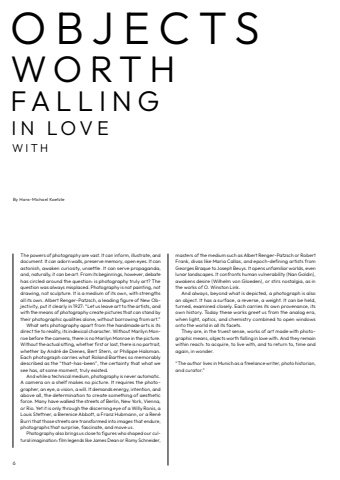Page 8 - Demo
P. 8
6masters of the medium such as Albert Renger-Patzsch or Robert Frank, divas like Maria Callas, and epoch-defining artists from Georges Braque to Joseph Beuys. It opens unfamiliar worlds, even lunar landscapes. It confronts human vulnerability (Nan Goldin), awakens desire (Wilhelm von Gloeden), or stirs nostalgia, as in the works of O. Winston Link.And always, beyond what is depicted, a photograph is also an object. It has a surface, a reverse, a weight. It can be held, turned, examined closely. Each carries its own provenance, its own history. Today these works greet us from the analog era, when light, optics, and chemistry combined to open windows onto the world in all its facets.They are, in the truest sense, works of art made with photographic means, objects worth falling in love with. And they remain within reach: to acquire, to live with, and to return to, time and again, in wonder.%u201cThe author lives in Munich as a freelance writer, photo historian, and curator.%u201dThe powers of photography are vast. It can inform, illustrate, and document. It can adorn walls, preserve memory, open eyes. It can astonish, awaken curiosity, unsettle. It can serve propaganda, and, naturally, it can be art. From its beginnings, however, debate has circled around the question: is photography truly art? The question was always misplaced. Photography is not painting, not drawing, not sculpture. It is a medium of its own, with strengths all its own. Albert Renger-Patzsch, a leading figure of New Objectivity, put it clearly in 1927: %u201cLet us leave art to the artists, and with the means of photography create pictures that can stand by their photographic qualities alone, without borrowing from art.%u201dWhat sets photography apart from the handmade arts is its direct tie to reality, its indexical character. Without Marilyn Monroe before the camera, there is no Marilyn Monroe in the picture. Without the actual sitting, whether first or last, there is no portrait, whether by Andr%u00e9 de Dienes, Bert Stern, or Philippe Halsman. Each photograph carries what Roland Barthes so memorably described as the %u201cthat-has-been%u201d, the certainty that what we see has, at some moment, truly existed.And while a technical medium, photography is never automatic. A camera on a shelf makes no picture. It requires the photographer, an eye, a vision, a will. It demands energy, intention, and above all, the determination to create something of aesthetic force. Many have walked the streets of Berlin, New York, Vienna, or Rio. Yet it is only through the discerning eye of a Willy Ronis, a Louis Stettner, a Berenice Abbott, a Franz Hubmann, or a Ren%u00e9 Burri that those streets are transformed into images that endure, photographs that surprise, fascinate, and move us.Photography also brings us close to figures who shaped our cultural imagination: film legends like James Dean or Romy Schneider, By Hans-Michael KoetzleO B J E C T S W O R T H F A L L I N G I N L O V E WITH


